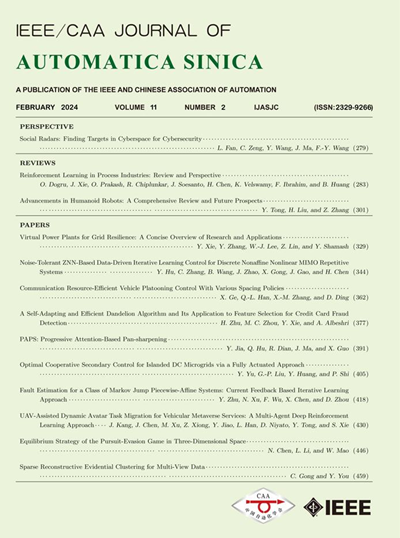A Hierarchical Stochastic Network Approach for Fault Diagnosis of Complex Industrial Processes
IF 19.2
1区 计算机科学
Q1 AUTOMATION & CONTROL SYSTEMS
引用次数: 0
Abstract
Complex industrial processes present typical uncertainty due to fluctuations in the composition of raw materials and frequently changing operating conditions. This poses three challenges for precise fault diagnosis, including random noise interference, less distinguishability between multi-class faults, and the new fault emerging. To address these issues, this study formulates fault diagnosis in uncertain industrial processes as a multi-level refined fault diagnosis problem. A hierarchical stochastic network approach is proposed to refine fault diagnosis of multi-class faults. This method considers the augmentation of fault categories as naturally following a hierarchical structure. At each hierarchical stage, stochastic network methods are designed according to the sources of uncertainty. For fault feature extraction, a doubly stochastic attention-based variational graph autoencoder is introduced to suppress noise during the message-passing process, ensuring the extraction of high-quality fault features and providing the provision of differentiated information. Subsequently, multiple stochastic configuration networks are deployed to realize multi-level fault diagnosis from coarse to fine granularity via a hierarchical structure rather than treating all faults equally. This approach effectively enhances the precision of multi-class fault diagnosis and ensures its robust generalization capability. Finally, the feasibility and effectiveness of the proposed method are validated using two industrial processes. The results demonstrate that the proposed method can effectively suppress the random noise interference and adapt to the emergence of small samples and imbalanced extreme fault-type data, achieving a satisfactory fault diagnosis performance.复杂工业过程故障诊断的分层随机网络方法
由于原材料成分的波动和操作条件的频繁变化,复杂的工业过程具有典型的不确定性。这给故障的精确诊断提出了三个挑战:随机噪声干扰、多类故障之间难以区分以及新故障的出现。针对这些问题,本研究将不确定工业过程的故障诊断表述为一个多层次的精细化故障诊断问题。提出了一种分层随机网络方法来改进多类故障的故障诊断。该方法认为故障类别的增加自然遵循层次结构。在每个分层阶段,根据不确定性的来源设计随机网络方法。在故障特征提取方面,引入了一种基于双随机关注的变分图自编码器来抑制消息传递过程中的噪声,确保提取出高质量的故障特征,并提供差异化的信息。随后,部署多个随机配置网络,通过分层结构实现从粗到细粒度的多级故障诊断,而不是对所有故障一视同仁。该方法有效地提高了多类故障诊断的精度,保证了其鲁棒泛化能力。最后,通过两个工业过程验证了该方法的可行性和有效性。结果表明,该方法能有效地抑制随机噪声干扰,适应小样本和不平衡极端故障类型数据的出现,取得了满意的故障诊断性能。
本文章由计算机程序翻译,如有差异,请以英文原文为准。
求助全文
约1分钟内获得全文
求助全文
来源期刊

Ieee-Caa Journal of Automatica Sinica
Engineering-Control and Systems Engineering
CiteScore
23.50
自引率
11.00%
发文量
880
期刊介绍:
The IEEE/CAA Journal of Automatica Sinica is a reputable journal that publishes high-quality papers in English on original theoretical/experimental research and development in the field of automation. The journal covers a wide range of topics including automatic control, artificial intelligence and intelligent control, systems theory and engineering, pattern recognition and intelligent systems, automation engineering and applications, information processing and information systems, network-based automation, robotics, sensing and measurement, and navigation, guidance, and control.
Additionally, the journal is abstracted/indexed in several prominent databases including SCIE (Science Citation Index Expanded), EI (Engineering Index), Inspec, Scopus, SCImago, DBLP, CNKI (China National Knowledge Infrastructure), CSCD (Chinese Science Citation Database), and IEEE Xplore.
 求助内容:
求助内容: 应助结果提醒方式:
应助结果提醒方式:


